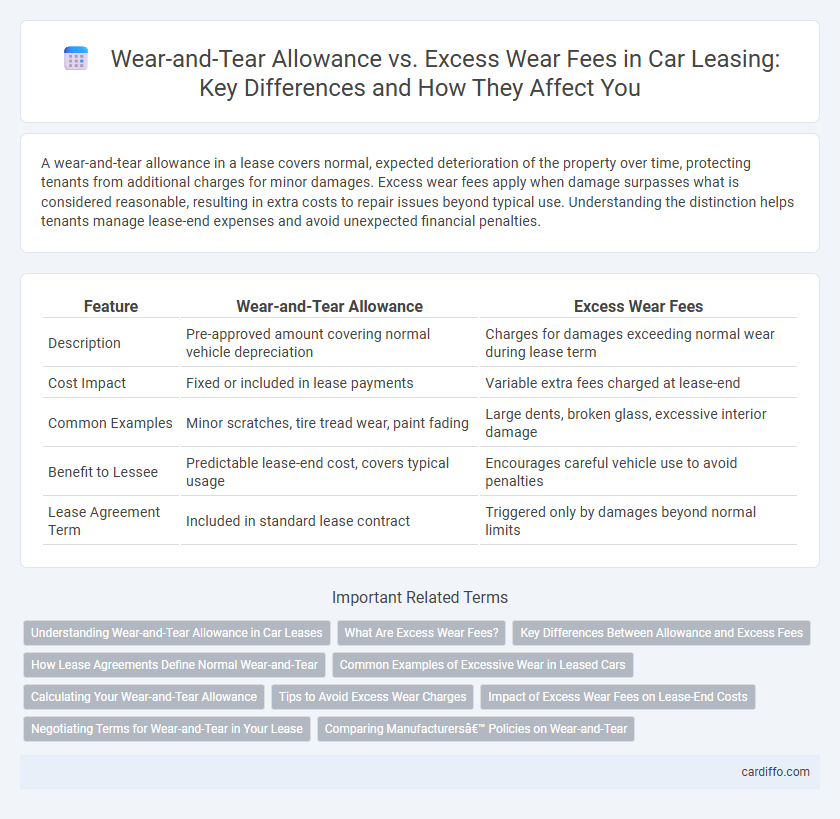A wear-and-tear allowance in a lease covers normal, expected deterioration of the property over time, protecting tenants from additional charges for minor damages. Excess wear fees apply when damage surpasses what is considered reasonable, resulting in extra costs to repair issues beyond typical use. Understanding the distinction helps tenants manage lease-end expenses and avoid unexpected financial penalties.
Table of Comparison
| Feature | Wear-and-Tear Allowance | Excess Wear Fees |
|---|---|---|
| Description | Pre-approved amount covering normal vehicle depreciation | Charges for damages exceeding normal wear during lease term |
| Cost Impact | Fixed or included in lease payments | Variable extra fees charged at lease-end |
| Common Examples | Minor scratches, tire tread wear, paint fading | Large dents, broken glass, excessive interior damage |
| Benefit to Lessee | Predictable lease-end cost, covers typical usage | Encourages careful vehicle use to avoid penalties |
| Lease Agreement Term | Included in standard lease contract | Triggered only by damages beyond normal limits |
Understanding Wear-and-Tear Allowance in Car Leases
Wear-and-tear allowance in car leases specifies the permissible level of depreciation and minor damages considered normal during the lease term, helping lessees avoid excess wear fees. This allowance often accounts for factors like small scratches, tire wear, and interior blemishes, reflecting typical usage without penalization. Knowing the specific thresholds outlined in the lease agreement helps drivers manage vehicle condition and anticipate potential costs at lease-end.
What Are Excess Wear Fees?
Excess wear fees are charges landlords impose when a tenant returns a leased property, such as a vehicle or equipment, with damage beyond normal wear and tear. These fees cover repairs or restoration needed to bring the item back to a condition consistent with the lease agreement's standards. Unlike the wear-and-tear allowance, which accounts for expected depreciation, excess wear fees apply specifically to damage exceeding ordinary usage.
Key Differences Between Allowance and Excess Fees
Wear-and-tear allowance represents a pre-agreed margin in a lease contract that covers normal vehicle depreciation due to regular use, while excess wear fees are charges imposed when damage surpasses this threshold. The allowance is included in the lease terms to avoid surprise fees at lease-end, typically calculated based on expected mileage and usage patterns. Excess wear fees vary by leasing company but are generally assessed per item of damage or level of wear beyond acceptable standards.
How Lease Agreements Define Normal Wear-and-Tear
Lease agreements typically define normal wear-and-tear as the expected depreciation occurring from regular use of the property or vehicle, excluding damages caused by negligence or misuse. Wear-and-tear allowances account for these minor, unavoidable deteriorations without penalizing the lessee, whereas excess wear fees are applied when damage exceeds what is considered normal usage. Clear definitions within lease contracts help distinguish permissible wear from chargeable damages, ensuring fair assessment and maintenance responsibilities.
Common Examples of Excessive Wear in Leased Cars
Common examples of excessive wear in leased cars include deep scratches, dents, and chipped paint that go beyond normal usage. Interior damage such as torn upholstery, stained carpets, and broken trim often leads to excess wear fees. Mechanical issues caused by neglect, like worn brake pads or damaged tires, are also typical reasons for additional charges on a lease agreement.
Calculating Your Wear-and-Tear Allowance
Calculating your wear-and-tear allowance involves assessing the expected depreciation based on the vehicle's age, mileage, and condition during the lease period. Lease agreements often specify a standard threshold for normal wear, such as minor scratches or tire wear, which falls under the allowable limits without extra charges. Exceeding these limits triggers excess wear fees, calculated per defined damage category, making precise allowance evaluation crucial to avoid unexpected costs at lease end.
Tips to Avoid Excess Wear Charges
Regularly inspect the vehicle for scratches, dents, and tire wear to address minor damages before lease-end inspections. Use protective accessories like seat covers and floor mats to minimize interior wear and maintain cleanliness throughout the lease term. Document the vehicle's condition with photos at lease signing and return to provide evidence against unjust excess wear fees.
Impact of Excess Wear Fees on Lease-End Costs
Excess wear fees significantly increase lease-end costs by charging lessees for damage beyond normal wear and tear, often leading to unexpected expenses. Lease agreements typically include specific criteria defining normal wear to protect lessees from excessive charges, but exceeding these limits triggers costly penalties. Understanding lease terms regarding excess wear fees is crucial for budgeting and minimizing financial impact at lease termination.
Negotiating Terms for Wear-and-Tear in Your Lease
Negotiating terms for wear-and-tear in your lease involves clearly defining the wear-and-tear allowance versus excess wear fees to avoid unexpected charges at lease-end. Specify acceptable conditions and set realistic thresholds for normal wear to protect against inflated fees for minor damages. Including detailed clauses on wear standards and fee structures ensures transparency and can lead to favorable adjustments in your lease agreement.
Comparing Manufacturers’ Policies on Wear-and-Tear
Manufacturers' wear-and-tear policies typically differentiate between a standard wear-and-tear allowance included in lease agreements and excess wear fees applied for damage beyond normal use. Toyota and Ford generally provide a wear-and-tear allowance covering minor scratches and tire wear, while Chrysler imposes stricter excess wear fees for damages such as upholstery tears or cracked windshields. Comparing these policies helps lessees anticipate potential fees and better maintain vehicle condition to avoid costly penalties at lease-end.
Wear-and-Tear Allowance vs Excess Wear Fees Infographic

 cardiffo.com
cardiffo.com